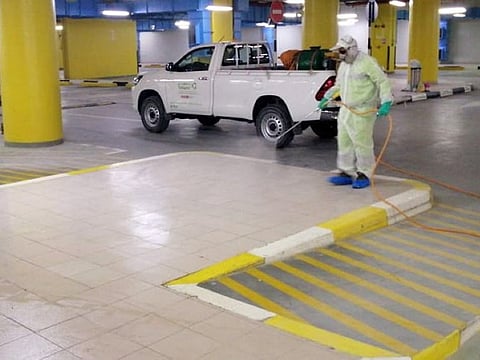How Abu Dhabi kept its worker residential areas safe amid the COVID-19 pandemic
245 inspections pointed out and corrected hazards at 167 worker residential areas

Also In This Package
Abu Dhabi: At the start of the COVID-19 outbreak, worker residential areas were viewed as high-risk areas for the spread of the virus. They were densely populated and included facilities shared by many at a time.
In Abu Dhabi, a dedicated team of inspectors, led by health and safety professionals, therefore got to work to ensure that worker residential areas in the capital and in Al Ain remained safe for their inhabitants.
Rapid assessment
The team got to work by May 2020, and in less than a month — specifically within 23 days — it had identified 5,000 risks, including 400 high-risk elements, at 167 worker residential areas.
“Each of these risks was then rapidly corrected by means of an action plan,” explained John Ewing, adviser to the Abu Dhabi Occupational Safety and Health System, an Abu Dhabi Government entity that ensures worker wellbeing. Speaking at a virtual conference organised by the Abu Dhabi Public Health Centre (ADPHC) on the occasion of World Day for Safety and Health at Work 2021, Ewing detailed how the project aimed to ensure the safety and education of all residents at workers’ cities.
Risks of worker housing
“Why did we focus on worker residential cities? These were viewed as the perfect environment for the spread of COVID-19. Between them, they house nearly half a million people in Abu Dhabi, and many facilities there are shared, including bedrooms, mess halls and bathrooms. They are also very densely populated and not all are regulated to the same standard,” Ewing said.
The inspection team developed a structure, with Ewing in the lead and Ibrahim Al Ali from the Abu Dhabi Public Health Centre acting as senior inspector. An external consultant was roped in to actually carry out the frontline inspections and deliver reports to the authorities.
Challenges
Ewing explained how the consultant-supplied inspectors worked in teams of two, and how all of them had to be rapidly trained to carry out the inspections. They also had to be taught to keep themselves safe.
“This led to a number of challenges, especially as the inspectors did not always know what they were looking for initially. Because they were not medically trained, they also had to be trained to safely put on full-body, medical-grade personal protective equipment, and this was also difficult to source in May 2020. The inspectors were also naturally concerned to be going into high-risk areas. But we managed to come through,” he said.
Inspection checklist
While the inspectors were rapidly trained, the senior team members developed a 65-point checklist for the inspections. In consultation with medical professionals, the items were also ranked in order of importance to risk prevention.
“We wanted to look at processes and procedures to protect the health of residents and prevent the further spread of COVID-19. The checklist focused on three main areas of focus: Facilities, individuals and logistics,” Ewing said.
What to check
Among the considerations for facilities, inspectors had to ensure that they were being regularly sanitised and that high-touch areas were being frequently disinfected. Each worker city also had to have dedicated a certain percentage of its capacity for quarantine and isolation.
All individuals had to be educated about how SARS-CoV-2 spread, especially as information about COVID-19 was initially scarce, unclear and rapidly changing. The inspectors had to therefore ensure that measures were being taken to educate workers.
The inspection teams finally looked at the adequacy of logistics for the isolation and transport of positive COVID-19 cases, the quarantining of contacts, and even security around quarantine and isolation areas. They also checked that the residential cities had provisions to ensure food, water and medical supply for all.
Aggressive project
An online platform was developed to collect all the information generated from the inspections and present it in an understandable format that allowed for action to be taken.
“We worked incredibly hard and the consultant inspection teams put in a total of 4,000 man hours over 23 days. Every high-level risk that was identified was immediately escalated for rapid action, including all cases of COVID-19 infection. The reports generated were shared with the authorities, as well as with the managers of the worker residential cities,” Ewing remembered.
From May 9 onwards, the teams inspected 20 worker accommodations a day between them, with some of them housing two workers and others with 50,000 inhabitants. After the capital city, teams also covered worker residential areas in Al Ain.
Amid many hurdles
The process was not easy, and a number of hurdles cropped up. At the time, government travel restrictions were in place and the inspections had to be carried out at a time when people were extremely stressed out about the COVID-19 outbreak. In addition, inspectors had to work in full-body PPE, despite soaring summer temperatures.
“Despite these, we were able to deliver the programme over 23 working days,” Ewing said.
This vital programme helped ensure that 5,000 COVID-19 hazards were eliminated at worker residential cities in Abu Dhabi and paved the way for authorities to begin mass COVID-19 screenings in the emirate from June 2020.
Sign up for the Daily Briefing
Get the latest news and updates straight to your inbox








